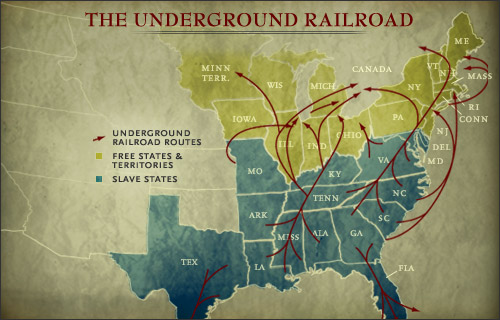"I was the conductor of the Underground Railroad for eight years, and I can say what most conductors can't; I never ran my train off the track and I never lost a passenger." (Harriet Tubman)

It had conductors, passengers, stations and stockholders. It had departures and arrivals. During its 20 year peak, it carried 30,000 people to freedom. By 1850, approximately 100,000 slaves had escaped on its routes. It was the Underground Railroad.
In 1804, black and white abolitionists in the United States joined together to form a series of meeting points, transportation, safe houses and personal assistance for escaped black slaves. Religious groups who supported the abolitionist movement included the Quakers, Congregationalists, Wesleyans, Reformed Presbyterians, Methodists and Baptists.

Harriet Tubman courtesy media.washtimes.com.
Conductors, who led groups of escapees to freedom, consisted of free blacks, white abolitionists, former slaves and Native Americans. Famous conductors included Harriet Tubman, who made 18 trips and saved 1000 people, and William Still, who harboured as many as 60 slaves a month in his Philadelphia home and Frederick Douglass, the finest abolitionist orator of his time.
Escaped slaves would travel by night between stations, which were located 10 to 20 miles apart. Stations could be barns, caves, hollowed out riverbanks, houses or hide outs under church floors. They usually travelled on foot or by wagon, but also travelled by boat or train. The routes they followed were indirect in order to confuse their pursuers. Wanted ads were often placed in local newspapers advertising the escape of slaves and a reward for their return. Federal marshalls and bounty hunters or slave catchers sometimes pursued escaped slaves as far as the Canadian border.

Wanted ad courtesy wordpress.com.
For the Underground Railroad to have been so successful, it had to be an organized operation. Accounts exist stating that escaped slaves would look for quilts hung on fences of safe houses. These quilts would have 10 patterns, each indicating a particular action for the slaves to take. A children's book called The Patchwork Quilt describes this practice. Others say that slaves were taught spiritual hymns with coded messages telling them how to find their way along the Underground Railroad. One song, "Follow the Drinking Gourd" describes how they followed a constellation shaped like a drinking gourd.
For some slaves, their destination was the Ohio River, code name River Jordan, since it marked the border between the slave states and free states. However, for others, their destination was Detroit, code name Midnight, and the Canadian border. Once in Canada, the majority of the escaped slaves settled in a triangular area bordered by Windsor, Toronto and Niagara Falls. Lieutenant General Simcoe had started the process of outlawing slavery in Upper Canada in 1793 by prohibiting the transportation of slaves into the province. However, smaller groups settled in Africville, Nova Scotia, Quebec and Vancouver Island. The law officially banned any form of slavery in Canada in 1833, thirty years before the Emancipation Proclamation in the United States.
Map courtesy indianapublicmedia.org.
Note: For more information, read The Underground Railway Records (William Still); The Life and Times of Frederick Douglass (Frederick Douglass); Harriet Tubman: The Road to Freedom (Harriet Tubman).

No comments:
Post a Comment